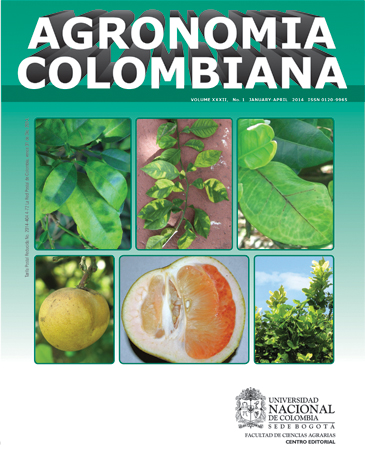Tree-ring growth and hydro-climatic variability in temperate dendrochronologies of northern Mexico
Crecimiento de anillos y variabilidad hidro-climática en dendrocronologías templadas del norte de México
DOI:
https://doi.org/10.15446/agron.colomb.v32n1.41271Keywords:
mensuration, climate change, bioclimatic indexes, El Niño-Southern Oscillation, Pacific Decadal Oscillation, Atlantic Multidecadal Oscillation (en)ediciones forestales, cambio climático, índices bioclimáticos, El Niño Oscilación del Sur, Oscilación Decadal del Pacífico, Oscilación Multidecedal del Atlántico (es)
Downloads
Este reporte plantea las siguientes preguntas: a) se encuentra el crecimiento diamétrico descrito por la anomalía de la amplitud del anillo de crecimiento estándar (SRWA) de árboles de Pseudotsuga menziesii (Mirb.) Franco relacionado con la precipitación (P), la evaporación (E), la evapotranspiración (Et), el escurrimiento (Q) y el contenido de humedad del suelo (θ), derivados de un modelo del balance hidrológico?; b) se encuentra el SRWA asociado con eventos climáticos sinópticos tales como El Niño-Oscilación del Sur (ENSO), la Oscilación Decadal del Pacífico (PDO), y la Oscilación Multidecadal del Atlántico (AMO)? y c) se encuentran P, Et y θ relacionados con ENSO, PDO y AMO? Los datos de SRWA para tres cronologías (Las Bayas y Banderas en Durango, y El Gato en Zacatecas) de 1665 hasta 2001 sirvieron para resolver estas preguntas. Mediciones instrumentales de P y E (1947-2007) y con el uso de sub-models paramétricos para la intercepción de la lluvia del modelo Gash (I) y Et, el procedimiento del balance de masas evaluó Q y θ para una cuenca cerca de El Salto, Durango, México. Oscilaciones de SRWA de varias escalas de tiempo mostraron picos espectrales cada 2-3; 3-7; y 9-12 años. Los índices de ENSO explicaron parte de la variación de SRWA para las tres cronologías (1990-2001). Para datos estacionales (1990-2001) y de escala mediana (1845-2001) θ explicó mejor la variación de SRWA. La fortaleza de la relación se debilita con la longitud de la serie de tiempo indicando otras variables controlan el crecimiento. El ENSO toma en promedio de 4 a 8 meses para mostrar su efecto en las variables hidrológicas locales y en el crecimiento diamétrico de árboles de P. menziesii del norte de México haciendo el crecimiento forestal predecible en el tiempo.
References
Arreola-Ortiz, M.R. and J.J. Návar-Cháidez. 2010. Análisis de sequías y productividad con cronologías de Pseudotsuga menziesii Rob. & Fern., y su asociación con EL Niño en el nordeste de México. Invest. Geog. 71, 7-20.
Biondi, F.L., A. Gershunov, and D.R. Cayan. 2001. North Pacific decadal climate variability since 1661. J. Climate 14, 5-10.
Briffa, K. 2000. Annual climate variability in the Holocene: interpreting the message of ancient trees. Quaternary Sci. Rev. 19, 87-105.
Cavazos, T. and S. Hastenrath. 1990. Convection and rainfall over Mexico and their modulation by the Southern Oscillation. Int. J. Climatol. 10, 377-386.
Cleaveland, M.K., D.W. Stahle, M.D. Therrell, J. Villanueva-Diaz, and B.T. Burns. 2003. Tree-ring reconstructed winter precipitation and tropical teleconnections in Durango, Mexico. Climate Change 59, 369-388.
Comrie, A.C. and E.C. Glenn. 1998. Principal components-based regionalization of precipitation regimes across the southwest United State and northern Mexico, with application to monsoon precipitation variability. Climate Res. 10, 201-215.
Cook, E.R. 2000. Niño 3 index reconstruction, unpublished data. In: National Climatic Data Center/National Oceanic and Atmospheric Administration (NOAA), www.ncdc.noaa.gov/data-access/paleoclimatology-data/datasets/climate-reconstruction; consulted: February, 2014.
Cook, E., J.S. Glitzenstein, P.J. Krusic, and P.A. Harcombe. 2001. Identifying functional groups of trees in west Gulf Coast Forests (USA): a tree ring approach. Ecol. Appl. 11, 883-903.
D'Arrigo, R., E. Mashing, D. Frank, and G. Jacoby. 2006. North Pacific-related climate variability inferred from seaward Peninsula, Alaska tree rings since A.D. 1358. Climate Dyn. 24, 227-236.
Dueñez-Alanís, J., J. Gutiérrez, L. Pérez, and J. Návar. 2006. Manejo silvícola, capacidad de infiltración, escurrimiento superficial y erosión. Terra Latinoam. 24, 233-240.
Enfield, D.B., A.M. Mestas-Nunez, and P.J. Trimble. 2001. The Atlantic multidecadal oscillation and its relation to rainfall and river flows in the continental U.S. Geophys. Res. Lett. 28, 2077-2080.
Fang, K., X. Gou, F. Chen, E. Cook, J. Li, and Y. Li. 2012. Spatiotemporal variability of tree growth and its association with climate over Northwest China. Trees 26(5), 1471-1481.
Fritts, H.C. 1976. Tree rings and climate. Academic Press, London.
García, E. 1987. Modificaciones al sistema de clasificación climática de Köppen (adaptación a la Republica Mexicana). 4th ed. Universidad Nacional Autónoma de México (UNAM), Mexico DF.
Gash, J.H.C., C.R. Lloyd, and G. Lachaud. 1995. Estimating sparse forest rainfall interception with an analytical model. J. Hydrol. 170, 79-86.
González-Elizondo, M., E. Jurado, J. Návar, M.S. González-Elizondo, J. Villanueva, O. Aguirre, and J. Jiménez. 2005. Tree-rings and climate relationships for Douglas-fir chronologies from the Sierra Madre Occidental, México: a 1681-2001 rain reconstruction. Forest Ecol. Manag. 213, 39-53.
Gray, S. and J. Betancourt. 2004. Atlantic multidecadal oscillation index reconstruction. In: National Climatic Data Center/National Oceanic and Atmospheric Administration (NOAA), ftp://ftp.ncdc.noaa.gov/pub/data/paleo/treering/reconstructions/amo-gray2004.txt; consulted: February, 2014.
Jones, D.L. 2003. El Niño, PDO, climatic cycles and drought in the Sierra Nevada. El Dorado County Water Agency; Water Resources Development and Management Plan, San Diego, CA.
Knight, J.R., C.K. Folland, and A.A. Scaife. 2006. Climate impacts of the Atlantic Multidecadal Oscillation. Geophys. Res. Lett. 33(17), LI7706.
Linderholm, H.W., B.O. Solberg, and M. Lindholm. 2003. Tree-ring records from central Fennoscandia: the relationship between tree growth and climate along a west-east transect. The Holocene 13(6), 887-895.
Mantua, N.J., S.R. Hare, Y. Zhang, J.M. Wallace, and R.C. Francis. 1997. A Pacific Interdecadal Climate Oscillation with impacts on salmon production. Bull. Amer. Meteor. Soc. 78(6), 1069-1079.
Návar, J. 2008. Atlas hidrológico del estado de Durango. Instituto Politecnico Nacional, Durango, Mexico.
Návar, J. 2013. The performance of the reformulated Gash's interception loss model in Mexico's northeastern températe forests. Hydrol. Proc. 27, 1626-1633.
Návar, J. 2014. Spatial and temporal hydro-climatic variability in Durango, Mexico. Tecnol. Cienc. Agua 1(1), 103-123.
Návar-Cháidez, J.J. 2011. Modelación del contenido del agua de los suelos y su relación con los incendios forestales en la Sierra Madre Occidental de Durango, México. Madera y Bosques 17(3), 65-81.
Návar-Cháidez, J.J. 2012. Modeling annual discharge for six Mexico's northern subtropical rivers. Rev. Ambient. Agua 7, 36-50.
Návar-Cháidez, J.J. and L.G. Lizárraga-Mendiola. 2013. Hydro-climatic variability and forest fires in Mexico's northern temperate forests. Geofís. Int. 52, 5-20.
Sheppard, P.R., A.C. Comrie, G.D. Packin, K. Angersbach, and M.K. Hughes. 2002. The climate of the US Southwest. Climate Res. 21, 219-238.
Stahle, D.W., R.D. D'Arrigo, P.J. Krusic, M.K. Cleaveland, E.R. Cook, R.J. Allan, J.E. Cole, R.B. Dunbar, M.D. Therrell, D.A. Gay, M.D. Moore, M.A. Stokes, B.T. Burns, J. Villanueva-Diaz, and L.G. Thompson. 1998. Southern oscillation index reconstruction. In: National Climatic Data Center/National Oceanic and Atmospheric Administration (NOAA), ftp://ftp.ncdc.noaa.gov/pub/data/paleo/treering/reconstructions/soi_recon.txt; consulted: February, 2014.
Stahle, D.W., M.K. Cleaveland, M.D. Therrell, and J. Villanueva-Diaz. 1999. Tree ring reconstruction of winter and summer precipitation in Durango, Mexico, for the past 600 years. pp. 205-211. In: Proc. 10th Symposium Global Change Studies. Amer. Meteor. Soc., Boston, MA.
Swetnam, T.W. and J.L. BetancourtJ. 1998. Mesoscale disturbance and ecological response to Decadal Climate Variability in the America Southwest. J. Climate 11, 3128-3147.
Therrell, M.D., D.W. Stahle, J. Villanueva-Diaz, E. Cornejo-Oviedo, and M. Cleaveland. 2006. Tree-ring reconstructed maize yield in Central Mexico: 1474-2001. Climate Change 74, 493-504.
Tingstad, A.H., and G.M. MacDonald. 2010. Long-term relationships between ocean variability and water resources in northeastern Utah. J. Amer. Water Resour. Assoc. 46(5), 987-1002.
Valente, F., J.S. David, and J.H.C. Gash. 1997. Modelling interception loss for two sparse eucalypt and pine forests in central Portugal using reformulated Rutter and Gash analytical models. J. Hydrol. 190, 141-162.
Worbes, M. 2002. Annual growth rings, rainfall-dependent growth and long-term growth patterns of tropical trees from the Caparo Forest Reserve in Venezuela. J. Ecol. 87, 391-403.
How to Cite
APA
ACM
ACS
ABNT
Chicago
Harvard
IEEE
MLA
Turabian
Vancouver
Download Citation
CrossRef Cited-by
1. José Návar. (2015). Hydro‐climatic variability and perturbations in Mexico's north‐western temperate forests. Ecohydrology, 8(6), p.1065. https://doi.org/10.1002/eco.1564.
2. Milton F. Alarcón-Jiménez, Jesús H. Camacho-Tamayo, Jaime H. Bernal. (2015). Management zones based on corn yield and soil physical attributes. Agronomía Colombiana, 33(3), p.373. https://doi.org/10.15446/agron.colomb.v33n3.51505.
Dimensions
PlumX
Article abstract page views
Downloads
License
Copyright (c) 2014 Agronomía Colombiana

This work is licensed under a Creative Commons Attribution-NonCommercial-ShareAlike 4.0 International License.
© Centro Editorial de la Facultad de Ciencias Agrarias, Universidad Nacional de Colombia
Reproduction and quotation of material appearing in the journal is authorized provided the following are explicitly indicated: journal name, author(s) name, year, volume, issue and pages of the source. The ideas and observations recorded by the authors are their own and do not necessarily represent the views and policies of the Universidad Nacional de Colombia. Mention of products or commercial firms in the journal does not constitute a recommendation or endorsement on the part of the Universidad Nacional de Colombia; furthermore, the use of such products should comply with the product label recommendations.
The Creative Commons license used by Agronomia Colombiana journal is: Attribution - NonCommercial - ShareAlike (by-nc-sa)

Agronomia Colombiana by Centro Editorial of Facultad de Ciencias Agrarias, Universidad Nacional de Colombia is licensed under a Creative Commons Reconocimiento-NoComercial-CompartirIgual 4.0 Internacional License.
Creado a partir de la obra en http://revistas.unal.edu.co/index.php/agrocol/.





















